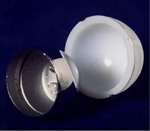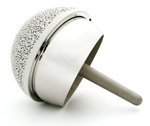Hip Resurfacing in the United States
 The concept of hip resurfacing was started in the United States in the 1970’s by Dr. Harlan Amstutz, as a way to save bone in younger patients during the treatment of hip arthritis. Dr. Amstutz had realized that traditional total hip replacement, while having a good lifespan in older patients, tended to fail early in younger patients because of their activity level. By saving femoral bone, Dr. Amstutz reasoned, there would be more options in the event that future surgery was necessary.
The concept of hip resurfacing was started in the United States in the 1970’s by Dr. Harlan Amstutz, as a way to save bone in younger patients during the treatment of hip arthritis. Dr. Amstutz had realized that traditional total hip replacement, while having a good lifespan in older patients, tended to fail early in younger patients because of their activity level. By saving femoral bone, Dr. Amstutz reasoned, there would be more options in the event that future surgery was necessary.
In the 1970’s, the only materials available for hip resurfacing were a metal ball and polyethylene (plastic) socket. Both implants were fixed to the bone with cement. An example of a first generation resurfacing implant is shown in Figure 1.
The problem with this design was that the polyethylene socket had to be extremely thin in order to conserve bone in the acetabulum. Thin polyethylene can lead to rapid wear, and the wear debris can cause bone resorption and implant loosening. Unfortunately this occurred in many patients, leading to failure within the first 5 years.
The high failure rate led to the abandonment of hip resurfacing until the materials and fixation could support the concept.
 The modern generation of hip resurfacing came about in the late 1990’s with the advent of improved manufacturing techniques for metal-on-metal joint replacements. Metal-on-metal implants had been used previously in total hip replacements dating back to the 1970’s (see Figure 2); however, manufacturing techniques did not have tight tolerances and on occasion the surfaces would “seize”and fail to move. In the 1990’s, the ability to make the metals more highly polished, spherical, and have tighter tolerances made it possible to produce reliable metal-on-metal joint replacements.
The modern generation of hip resurfacing came about in the late 1990’s with the advent of improved manufacturing techniques for metal-on-metal joint replacements. Metal-on-metal implants had been used previously in total hip replacements dating back to the 1970’s (see Figure 2); however, manufacturing techniques did not have tight tolerances and on occasion the surfaces would “seize”and fail to move. In the 1990’s, the ability to make the metals more highly polished, spherical, and have tighter tolerances made it possible to produce reliable metal-on-metal joint replacements.
The metal-on-metal design was perfect for hip resurfacing because the metals were durable enough to make them into thin shapes, allowing for the preservation of bone. The current generation of hip resurfacing implants allow more bone to be saved than the first generation design.
Although some modern generation hip resurfacing designs were used in the late 1990’s outside of the United States, it was not used in the USA until 2001. Dr. Harlan Amstutz continued to champion the idea of hip resurfacing and developed the Conserve Plus implant, which went into clinical trials in 2001.
 From 2001-2006, hip resurfacing was performed in limited numbers, as it was only available through clinical trials. The Biomet Recap implant was in clinical trials starting in 2005. In May 2006, the Birmingham hip resurfacing (see Figure 3) was approved by the US FDA, based upon its excellent track record in the United Kingdom.
From 2001-2006, hip resurfacing was performed in limited numbers, as it was only available through clinical trials. The Biomet Recap implant was in clinical trials starting in 2005. In May 2006, the Birmingham hip resurfacing (see Figure 3) was approved by the US FDA, based upon its excellent track record in the United Kingdom.
Shortly after its approval, Dr. Edwin Su performed one of the first BHR’s in the USA, and the first in New York State. Currently the BHR and the Conserve Plus are the only FDA approved implants available in the United States.
Dr. Edwin Su is now one of the most experienced hip resurfacing surgeons in the United States, having performed over 2000 hip resurfacing operations. He is regularly invited to lecture at educational courses, perform live surgical demonstrations, and train other surgeons.
The Center for Hip Pain & Preservation
541 East 71st Street
New York, NY 10021
 Click here for Driving Directions
Click here for Driving Directions

















